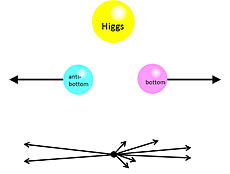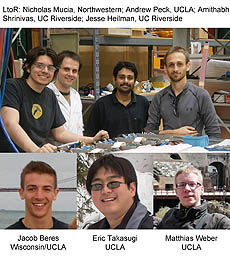The messy strong force
 |
| A simple description of a particular event might be how a Higgs boson (top) decays into a bottom quark-antiquark pair (middle). However the reality is much messier, involving a complex spray of particles. Today's analysis is a study of the details of how a couple of quarks can turn into a much more complicated collection of particles. |
When scientists explain how interactions occur at colliders like the LHC, they often have to rely on approximate descriptions. For instance, in discussions of the production and decay of a Higgs boson, we often mention that its most likely decay mode is into two bottom quarks. We then draw a simple picture, with a Higgs boson decaying and two quarks flying away from the decay point. This picture is accurate to a point, but beyond that it's far messier.
Like all quarks, bottom quarks carry color (the charge of the strong nuclear force) and feel a mutual interaction. Because of the way the strong force works, as the two quarks get farther apart, the force increases, leading to an increase in the energy stored in that force. This concentrated energy eventually results in something akin to a spark, and a gluon is emitted. Since the gluon also carries color, it too experiences a force between itself and the original quarks, and so the process repeats.
With all these colored objects flying around, the whole process of two quarks separating turns into a complicated mess of quarks and gluons, all traveling in more or less the same direction. Each of these particles carries a fraction of the energy of the original two bottom quarks, and eventually the energy each one carries is too low to radiate more gluons. The particles then combine to form various mesons, which is what we eventually observe. This blast of observable particles heading in essentially the same direction is called a jet.
A scientist analyzing the data has to cope with all of these realities. In order for an analyzer to understand how these complicated processes transform the simple idea (a Higgs boson decaying into two bottom quarks) into what is actually observed (two jets), it is very helpful to have computer programs that accurately simulate all of these effects. With this capability, physicists can compare the conceptually simple situation to the prediction of what the two jets will look like in real data. Knowing the interaction's starting and ending points, the analyzer can figure out how to extract the desired quantities from actual data measurements.
Before scientists can use this technique to analyze data with the potential for a discovery, they must compare the simulations programs to well-understood real data to verify the simulations' quality. CMS physicists studied the details of how jets formed in many different situations. The example of a Higgs boson turning into two quarks, which subsequently form jets, is among the simplest of the examples. The process of jet formation is caused by pairs of colored objects feeling a mutual interaction, but in a more complex process (like the production of a top quark-antiquark pair, in which six or more quarks and gluons are expected to be produced), things can get much messier.
CMS scientists studied the structure of jets for many different kinds of events. These studies provided both a powerful validation of the calculations and data that would further refine the programs.
—Don Lincoln
 |
| These US CMS scientists contributed to this analysis. |
 |
| Construction of the ME4/2 muon chambers relies critically on these junior scientists. Under the guidance of muon experts, they clean panels, glue components, test high voltage, wind wires, assemble chambers, install and repair electronics, and perform final tests. When the LHC turns back on, they will be able to analyze LHC data with a detector they helped build. |
|